Last updated: 3 September 2023
Are you planning a trip to Nuremberg Germany soon and looking for the best places where to eat? Well, you’ve come to the right post because that’s exactly what this article is going to cover! Sampling a local or regional cuisine should absolutely be on your list of things to do when you’re travelling. People express themselves and their culture through food and Franconia, in Bavaria, Germany, is no different. So for our 48 hours in Nuremberg guide, we help take the stress out of which traditional and regional specialties to sample and where to eat in Nuremberg.
Where to eat in Nuremberg, Germany
[lwptoc]
11 of the Best Things to do in Nuremberg
Specialty Snacks in Nuremberg
Nuremberg Rostbratwurst (Sausage)
Few things are more stereotypical than the Germans and their sausages. In fact, the sausage has been a loved and treasured symbol of the city for some 700 years.
In 2003, the local Bratwurst of Nuremberg, the Nuremberg Rostbratwurst, was the first sausage to be accepted on the EU PGI registry, which recognizes traditional, locally-produced specialties in the European Union.
The Nurembergers are so proud of their wurst, that in 1989 the Nuremberg Sausage Protection Association was founded with the goal of protecting the quality, recipe and typical characteristics of the Nuremberg Rostbratwurst!
Not dissimilar to the DOC applied to many Italian household names like Parmigiano Reggiano or balsamic vinegar, products with a PGI (Protected Geographical Indication) status, must be traditionally and at least partially manufactured within the specific region and thus acquire unique properties. Products that pass the rigorous tests, can be stamped with the official seal of the EU and called a “Nuremberg Rostbratwurst”
For the Nuremberg Bratwurst to be named one, it must be made to an official recipe, which dictates only coarsely-ground lean pork may be used to create these sausages, cooked on an open fire of beechwood, be between 7-9cm long, weigh no more than 25g and also manufactured within the city limits.
The Nuremberg Rostbratwurst is noticeably smaller than the average German sausage. There are several theories and local legends that attempt to explain this anomaly.
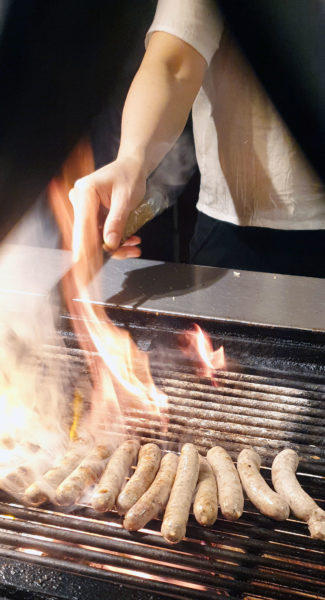
According to Legend…
Some say that the Rostbratwurst were made small enough to pass through the keyholes of prisons and homes during the Plague, or the slightly more plausible, that butchers reduced the size of the sausage but kept the price remained the same, enabling them to use less ingredients and make the same amount of money, earning them a nice little profit.
How to Have Nuremberg Rostbratwurst?
There’s a few ways to eat the famous Nuremberg sausage.
One is to order it the Franconian way: “Drei im Weggla” (translation: three in a bun), or served on a pewter plate (often heart-shaped) with typical side dishes of sauerkraut, mustard or horseradish, which is called “Kren” in the local dialect.
In addition to the delicious grilled version, you’ll also find “Saure Zipfel”. It’s the same sausage, just cooked differently. Cooked slowly in a broth flavoured of wine, onions, vinegar, and spices, they have a sour-fermented-like taste and a slightly anaemic look about them, beige with a sometimes bluish-grey colour, which has led to the nickname of “Blue tails”.
My preference for Nuremberg Rostbratwurst is to be charred over an open flame served in a crunchy roll, drei im weggla style!
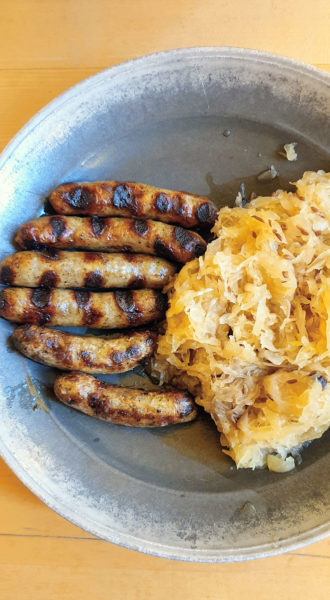
Where to Get Nuremberg Rostbratwurst?
This wooden tavern sits on Rathausplatz, in the shadow of the imposing St Sebald Church and opposite the city’s Town Hall. What ordinarily could be considered a tourist-focused location, Bratwursthäusle bei St. Sebald is a local haunt, serving up the traditional Nuremberg sausage to those wishing to dine in, or take away.
Pewter plates serve up char-grilled, smoked and sour sausages to those wishing to dine in, or simply grab three in a bun and be on your way. If the weather is fine, grab a seat outside and people-watch while you sip local beer and devour Nuremberg Rostbratwurst.
Other Places to Get Nuremberg Rostbratwurst
Lebkuchen (Gingerbread)
Gingerbread is normally associated with Christmas, but not in Nuremberg. Lebkuchen as it’s known in Nuremberg is a year-round delight.
First baked by Franconian monks as early as the 14th century. The unique recipe was, thanks to the city’s strategic location, at the intersection of trading routes providing ready access to exotic spices like cinnamon, cloves, cardamom, nutmeg and almonds.
Recipes are closely guarded secrets, having been handed down from generation to generation. However in July 1996, the Nuremberg Lebkuchen was recognised in Europe with PGI status and the EU seal.
The most loved version of Lebkucken is Elisenlebkuchen.
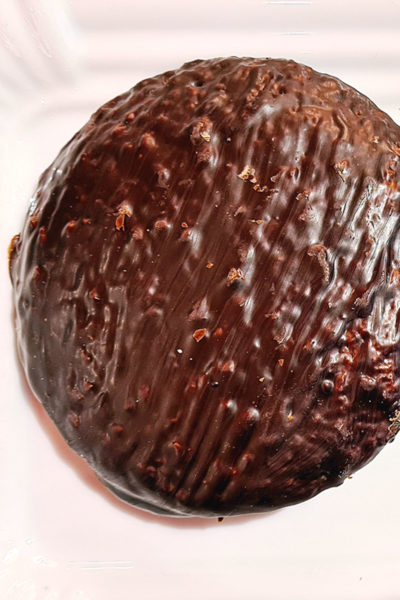
What’s in a Name? Elisenlebkuchen
The masterpieces of the gingerbread trade are the Elisenlebkuchen, which, according to legend, was named after the daughter of a master baker. Today, Elisenlebkuchen can contain no more than 10% flour and must have at least 25% nuts, along with a long held secret of how to avoid the gingerbread sticking to the tray when baking.
Round in shape, not dissimilar to a cookie, they can be large up to 4-5 inches in diameter with a sweet aromatic scent of earthy spices and glazed with a combination of powdered sugar, and liquid dark chocolate and decorated with almond halves and/or candied lemon.
Elisenlebkuchen producers are very proud of their craft, and many make their packages as fine as their contents, using decorative tins and trunks which can be coveted by collectors.

Where to Try Lebkuchen?
For people of Nuremberg, “der Neef” is an institution. This family-owned business has been a “Nuremberger Meisterhändler”, artisan specialists in their trade, for more than four decades. Situated close to Nuremberg’s main market square, this unimposing cafe serves up delicious cakes and of course Elisenlebkuchen.
A fourth generation family business, Fraunholz has been serving Nuremberg Elisenlebkuchen and pastries for over a century.
Today, Fraunholz is a specialist for the very finest Elisenlebkuchen, making it completely without flour and contains more than 40% nuts!
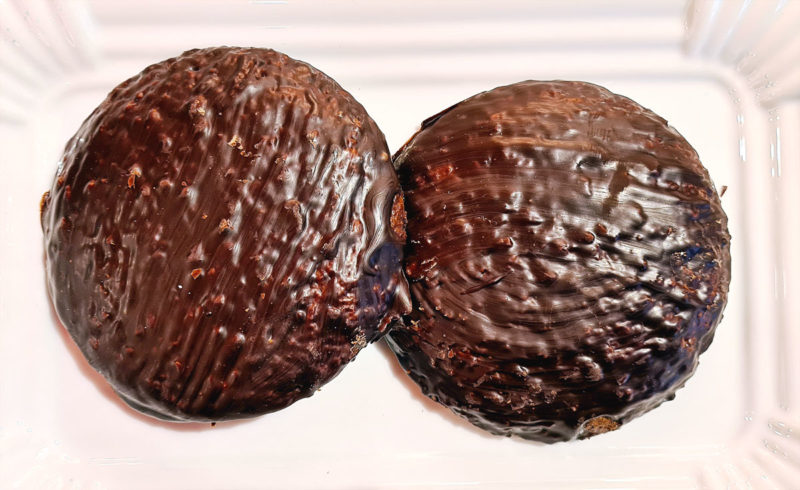
Pretzel at Brezen Kolb
Do one thing, and do it very well should be the motto for Brezen Kolb. Another family run business, Brezen Kolb has been in operation since 1957, with three generations having led Brezen Kolb to the place of being the number one pretzel establishment in Nuremberg, with a countless number of kiosks across the city. Rest assured, they found a new fan in me. Often called a brezel, their product is soft and chewy and makes a great snack on the go.
Cooked in a special stone-oven, bretzels come in plain, seeded, salted and flavoured varieties, with fillings from the oh-so-Franconian style of just butter, to cheese, tomato & Mozzarella, salami, camembert, garlic and chives and more.
Where to Get a Pretzel from Brezen Kolb?
There are many Brezen Kolb kiosk’s throughout Nuremberg so you’ll like stumble across them during your time exploring the city. However, if Brezen Kolb is your intended destination then Google Maps will be your best friend to find your closest location.
Specialty Drinks in Nuremberg
Rotbier (Red Beer)
Once upon a time, people, including children, drank beer instead of water because it was deemed to be the safest liquid to consume. For the people of Nuremberg, their drink of choice was Rotbier, or Red Beer.
Nuremberg breweries follow local regulations for Rotbier. These regulations strictly regulate what ingredients can be used. Thanks to the German Beer Purity Law (Reinheitsgebot) of 1516, the only ingredients that could be used in the production of beer were water, barley, and hops. It wasn’t until later that they realised yeast was also an essential ingredient in the brewing process.
Rotbier is a bottom-fermented beer. The fermentation process for bottom-fermented beer must be done slowly and at low temperatures. Which is perfect for Nuremberg, because deep within the sandstone hill on which Nuremberg’s castle sits, lies one of the city’s highlights, medieval rock cut cellars, which are cut up to four stories deep! With stable and cool temperatures, it was established very early on that this was ideal for fermenting rotbier.
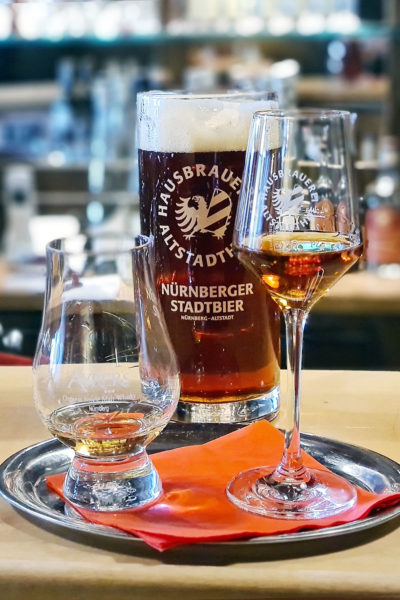
Today there’s been a resurgence of interest in Rotbier. Despite the resurgence, it’s not quite where it was at its peak in 1597. At this time, the city had more than almost three-dozen breweries brewing rotbier, and eleven brewing white beer, which is another favourite in the city.
Where to Get Rotbier?
Located on the foothills of Nuremberg castle, Hausbrauerei Altstadthof was one of the first breweries to brew Rotbier.
This family business established in 1984, makes organic red beer brewed with a special roasted malt and aromatic hop varieties. They brew from a historic recipe and use traditional equipment such as copper kettles, and wooden fermentation tanks.
The result is a velvety-soft beer with mild notes of sweetness and an ABV of 5.2% vol.
Other Places to Try Rotbier:
If you’re interested in discovering the labyrinthine of cellars that lies beneath the old town, there are several tours that explore the historic rock-cut cellars that once stored the beer. Some cellars were also used to store priceless works of art during World War II, when 95% of the old city was destroyed by Allied bombers.
Specialty Main Meals in Nuremberg
Schäufele (Pork)
Schäufele is a very Franconian dish of epic and robust proportions. Essentially it’s a slow cooked pork shoulder complete with bone and rind.
The origins of the name come from the local dialect for the bone, which apparently resembles a little shovel, thus the dish being called Schäufele, the German word for shovel.
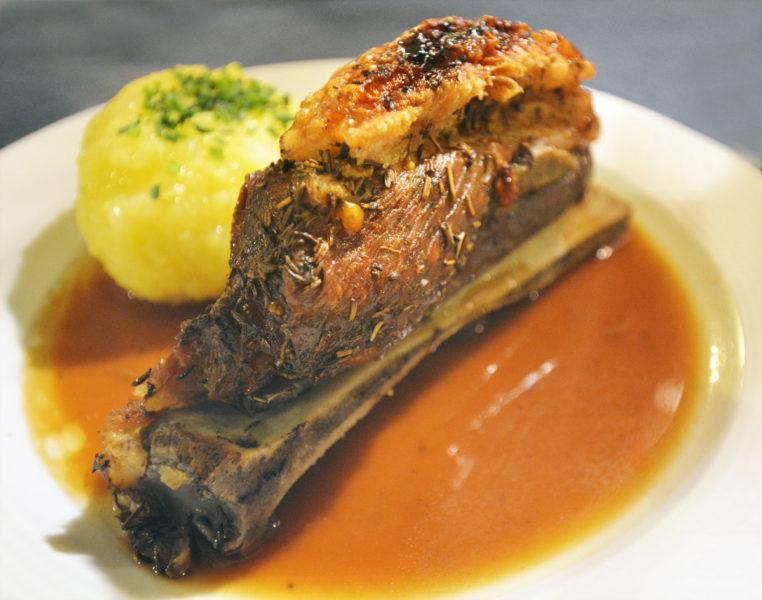
Franconians are incredibly proud of this dish, with lean meat which is soft and tender, and melts in your mouth like butter, while the rind and crackling is crisp and crunchy. The bone provides some logistical challenges but adds flavour to the overall dish.
The preferred side dish to the hearty Franconian Schäufele is a potato dumpling and red savoy cabbage or sauerkraut, while in summer you can expect a side salad accompaniment.
Where to Get Schäufele?
For an unpretentious and authentic Franconian restaurant in Nuremberg head to Albrecht Dürer Stube.
The menu serves Schäufele alongside a range of classics including Nuremberg rostbratwurst, steaks and fish with drinks including Franconian wine and Landbier.
The Durer-inspired dining room is snug so book ahead for peak period and weekends and expect to share your table with strangers.
Other Places to Try Schäufele
- Hausbrauerei Altstadthof – As you would expect, they have their own take on Schäufele, by cooking the pork in Franconian rotbier sauce and served with potato dumplings
- Schanzenbräu which quite literally translates to Shovel industry!
There is just five dishes to get you started while discovering the fabulous city of Nuremberg, which one will you try first? Tell us by leaving a comment below.
Final Thoughts
There are so many wonderful places to visit and delicious things to eat during your time in Nuremberg that we hope that this post has help in building a Must Visit list! If you have any questions or need any further suggestions then don’t hesitate in leaving us a comment or drop us an email here. Travel safe.
We thank Nuremberg Tourism for their assistance on this trip. For more information about visiting Nuremberg, check out their website.
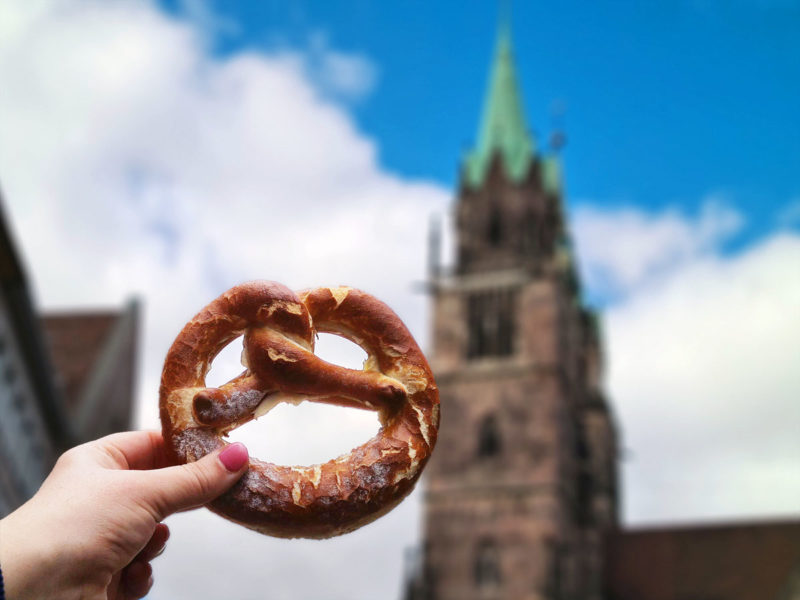
The Elisenlebkuchen sound amazing! Mind you so do the Lebkuchen and the Pretzels….
I can attest, they were ALL very very yummy!